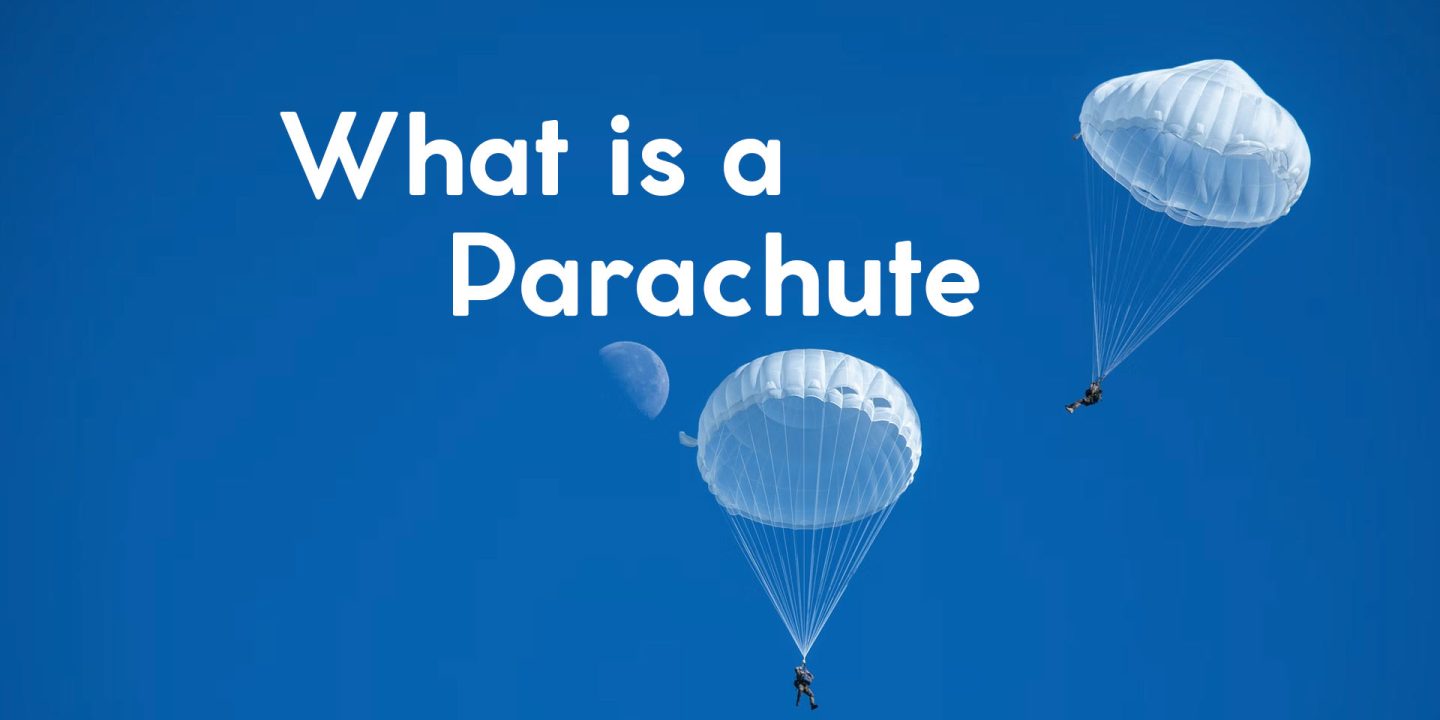
What is a parachute?
A parachute is a device used to slow the descent of an object through the air. It is typically used in emergency situations requiring rapid descent, such as when ejecting from an aircraft. Parachutes are also commonly used for recreational activities such as skydiving and BASE jumping.
The word “parachute” comes from the French word para, meaning “to protect against,” and chute, meaning “a fall.” The first recorded use of a parachute was by Leonardo da Vinci in his design of a flying machine. However, it is unclear if this design was ever actually built or tested.
Sebastien Lenormand invented the first practical parachute in 1783. It was used to save the life of a hot-air balloonist who had been blown off course and was about to crash.
Parachutes work by creating drag, or resistance to movement through the air. This drag forces the object to fall more slowly than it would without the parachute. The amount of drag produced by a parachute can be increased by making the parachute larger or by increasing its surface area.
Parachutes are usually made from light, strong materials such as nylon or Kevlar. The material is woven into a large, open canopy that can be deployed quickly in an emergency. The canopy is attached to the object using cords or straps.
When deployed, parachutes fill with air and slow the descent of the object. Parachutes are typically used in situations where a rapid descent is required, such as when ejecting from an aircraft. They can also be used for recreation, such as skydiving and BASE jumping.
How does a parachute work?
A parachute works by creating drag, or resistance to movement through the air. This drag forces the object to fall more slowly than it would without the parachute. The amount of drag produced by a parachute can be increased by making the parachute larger or by increasing its surface area.
When a parachute is deployed, it fills with air and slows the descent of the object.
The history of the parachute
The parachute is a device that has been used for centuries to slow down or stop the fall of an object. The word “parachute” comes from the Greek words para (against) and chute (fall), and it first appeared in the French dictionary in 1785. The earliest recorded use of a parachute was by Fausto Veranzio, a Venetian inventor, who used one to escape from a hot air balloon in 1617.
Frenchman Louis-Sebastien Lenormand invented the modern day parachute in 1783, and it was first used in battle by Andrea Pozzo, an Italian Jesuit priest, during the Austrian siege of Mantua in 1796. Napoleon Bonaparte is credited with popularizing the parachute during the Napoleonic Wars, when he ordered his troops to use them to escape from hot air balloons that had been shot down.
Etienne Girardet made the first recorded parachute jump for amusement in 1797. He jumped from a height of 3,200 feet (975 meters) into a lake near Geneva, Switzerland. In the early 1800s, balloonists in Europe and the United States began using parachutes as a safety measure.
The first woman to make a parachute jump was Eliza Greene, who did so in 1837. The first person to jump from an airplane was Albert Berry, who used a parachute to bail out of his plane after it ran into engine trouble in 1912.
Parachutes are now used for a variety of purposes, including recreation, sports, and military operations. They have also been used to deliver supplies to people in remote areas, and to drop food and other supplies to people stranded on mountaintops or in other disaster areas.
The different types of parachutes
Different types of parachutes are designed for different purposes and environments. Military parachutes are typically designed for maximum durability and performance under extreme conditions, while recreational parachutes are usually designed for lighter loads and more forgiving conditions. Here are some of the most common types of parachutes:
Round Parachute: The round parachute is the most basic type of parachute, and is typically used in emergency situations where speed and simplicity are paramount. Round parachutes are easy to deploy and can be packed into a small space, but their round shape makes them less aerodynamic than other types of parachutes.
Ram-Air Parachute: The ram-air parachute is the most popular type of parachute used today. It uses a series of fabric panels (known as cells) to inflate into a wing-like shape, which provides excellent aerodynamic performance. Ram-air parachutes are used for both recreational and military purposes.
Paraglider: A paraglider is a lightweight, foot-launched aircraft that uses the same principles as a ram-air parachute. Paragliders are very maneuverable and can be flown in a variety of conditions, making them popular with both recreational and military pilots.
Powered Parachute: A powered parachute is a type of parasailing equipment that uses a motorized fan to provide lift. Powered parachutes are used for recreation and commercial purposes, and can even be used to tow skiers or supplies behind a boat.
There are many other types of parachutes not listed here, but these are some of the most common. When choosing a parachute, it’s important to consider the purpose for which it will be used, as well as the conditions in which it will be deployed.
How to pack a parachute
Assuming you would like a generic answer on how to pack a parachute:
The first step is to make sure that the parachute is completely unfolded and laid out flat.
Once it is unfolded, check all of the grommets to ensure that they are secure and not torn.
Next, locate the suspension lines and arrange them in order from shortest to longest.
Once this is done, you can start packing the parachute into the container. Make sure that you pack it loosely, as a tight pack can cause the parachute to malfunction.
Once it is packed, close the container and secure it with the appropriate straps or buckles.
How to use a parachute
A parachute is a device used to slow the descent of an object through the atmosphere. It is typically deployed via a ripcord, and allows skydivers, BASE jumpers, and other freefall enthusiasts to safely return to earth.
There are three main types of parachutes: round, square, and rectangular. Round parachutes were the first type of parachute ever invented and are still used today in some military applications. Square and rectangular parachutes are more common in recreational use, as they offer more control and stability in flight.
To use a parachute, simply pull the ripcord when you are ready to deploy it. The canopy will open automatically, and you will begin to descend at a slower rate. To steer the parachute, use the toggles on the risers (the cords connecting the canopy to the harness). Pushing down on one toggle will cause the parachute to turn in that direction.
Once you have landed, it is important to carefully pack up your parachute so that it is ready for use next time. Most parachutes are packed in a backpack or duffel bag, which can be easily carried on your back during a hike or other outdoor activity.
The benefits of using a parachute
A parachute can be a very useful tool, especially when it comes to emergency situations. Here are some of the benefits of using a parachute:
- It can help to slow you down. If you are falling from a great height, a parachute can help to reduce your speed and prevent you from hitting the ground at a high rate of velocity.
- It can help to keep you safe. In an emergency situation, a parachute can provide you with a way to escape from danger or reach safety.
- It can help to improve your chances of survival. If you are in an accident or emergency situation, having a parachute can increase your chances of being found and rescued.
- It can be used for recreation. Many people use parachutes for activities such as skydiving and BASE jumping.
- It can be used for transportation. In some cases, parachutes have been used to transport people and supplies to remote areas.
- It can help you to reach your destination. If you are stranded in a remote location, a parachute can provide you with a way to reach civilization.
- It can provide you with a sense of security. Knowing that you have a parachute can give you peace of mind in situations where there is danger of falling.
- It can be used as a tool for education. Parachutes can be used to teach children about safety, physics, and other concepts.
- It can be used for research. Scientists have used parachutes to study the effects of gravity and air resistance.
- It can be used for art. Parachutes can be used to create sculptures or other works of art.
The risks of using a parachute
There are a few risks associated with using a parachute, the most serious of which is entanglement. If the lines of the parachute become entangled, it can cause the parachute to malfunction and fail to open properly. This can lead to serious injury or even death.
There is also a risk of the parachute not opening at all, which can also be fatal. Parachutes are also subject to wear and tear, and if they are not properly maintained, they may not work correctly. Finally, there is always a risk that the parachute will not deploy correctly, which could lead to a dangerous fall.









